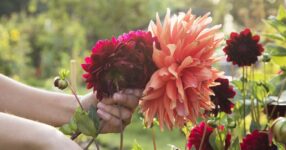
Monty Don shares ‘particular’ plant to deadhead within weeks
Gardening guru Monty Don has urged Britons to undertake an important task over the next few weeks.
He revealed that deadheading is a priority for those who are growing certain plants in their outdoor space. Deadheading is the easiest way to improve the performance of flowering varieties, though only when aptly timed.
The gardening task is usually done when blooms begin to dwindle; for example, lace-cap hydrangeas respond best when deadheaded before early August.
Depending on the hardness of the stem, deadheading is the removal of declining flowers from a plant with fingers, scissors, or hand pruners.
Sharing insight in his monthly blog, Monty suggested that gardeners focus on dahlias as autumn progresses, particularly during October.
The gardening expert said: “Keep deadheading throughout October, particularly the equatorial plants like dahlias. This will extend their flowering season and squeeze the last bloom from them.”
Monty acknowledged that “spent” dahlia flowers – those that have passed their prime and are no longer considered attractive – are hard to differentiate from those that haven’t opened their buds.
To avoid plucking those that haven’t had a chance to bloom, he suggested studying the shape carefully. “The foolproof difference is that when they have finished flowering they become pointed and a cone shape, whereas the unopened buds are rounded,” said Monty.
Another telltale sign of spent dahlias is in the centre of the flower. In a fresh bloom, the centre is usually tightly closed or just beginning to open.
However, spent blooms will have a fully-opened core that reveals the structures inside, which can start to look dry or hollow. The stem may also look weak or bent just below the flower head.
As for how to deadhead dahlias, a good quality pair of gardening shears or scissors is essential. Always ensure they are clean and sharp to make a clean cut without damaging the plant.
How to deadhead dahlias
Locate the spent bud then trace the stem of the spent flower down to where it meets the first set of healthy leaves or a new budding flower
Angle the cut to 45 degrees about one-quarter of an inch above the node or new bud – doing so helps prevent water from settling on the cut surface, reducing the risk of disease.
Make a precise, gentle cut to ensure the remaining stem is not damaged. After you’ve deadheaded, give the plant a quick check for disease or pests and treat accordingly.



